|
| Front page | | Contents | | Previous | | Next |
Development of cleaner products in Berendsen's international product chains
Appendix C
Workshop: ”Experience with development of sustainable products in co-operation with suppliers”
On 10 November 2005 FORCE Technology, Berendsen Textil Service A/S, EcoForum and LCA Center arranged an “after-work workshop” in co-operation with the Danish Environmental Protection Agency.
Presentations
Initially, Christian Steen, Berendsen Textil Service A/S, and Jeppe Frydendal, FORCE Technology/LCA Center, made a presentation on barriers for development of cleaner products in international product chains with basis in cases and experience of Berendsen Textil Service A/S.
[Presentations are in Danish]
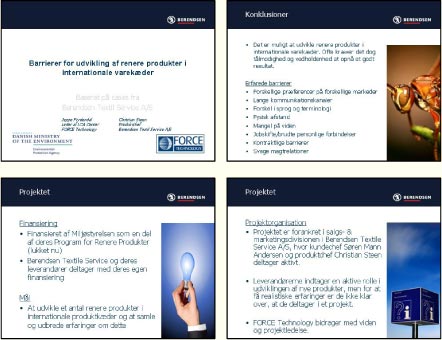
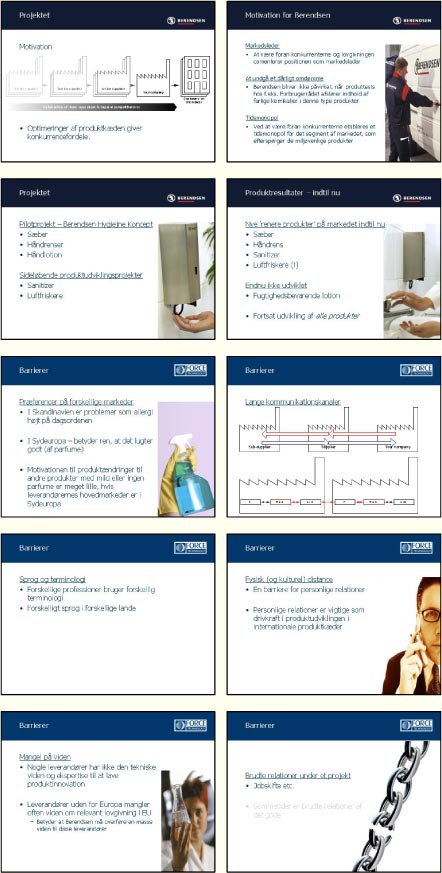
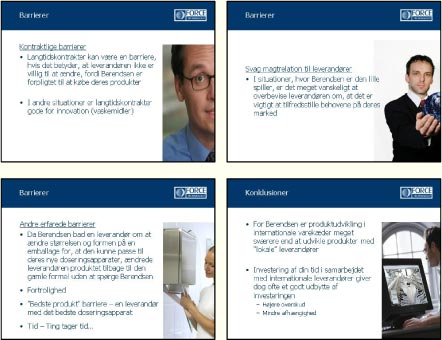
Jonas Engberg, IKEA, followed with a presentation of IKEA’s work to overcome barriers for sustainable development in their supplier chains.
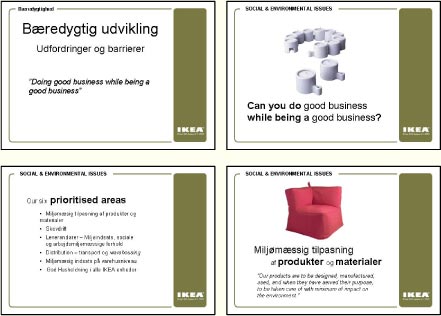
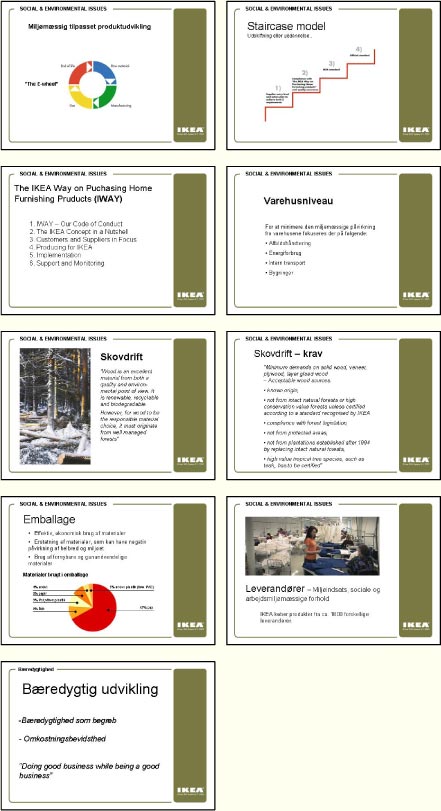
Active group discussions
Then there was a planned group work with starting point in a number of dilemmas connected to handling of divergent demands from customer and problems in relation to implementation of Code of Conduct respectively.
Handling of the customers’ demands
As a supplier you can experience that your customers have different opinions and priorities when it comes to demands to sustainability. The specific demands of your customers can vary both in content and form as well as demands to documentation. Question is how a company can relate to the many and often divergent demands and how the company in the best way can relate to individual cases which suddenly appear. On basis of the discussions in two groups several different input were presented.
Customer demands represent a potential
It was stated that basically customer demands should be seen as a potential and a possibility for development and innovation. Demanding customers are not only “troublesome” but can contribute to open new perspectives and possibilities and to develop the supplier.
It is important with own approach and effort
Both groups emphasized that it is important to define your own approach. To identify where the possibilities of the company are as well as where and how the company gets “most environment for the money”.
Systematic approach to handling of the customers’ demands
Demands from many different customers make it necessary to systematize and analyse which inquiries requiring action, which can be put on “stand-by” and which can be disregarded. It was emphasized that a large part of the customers’ demands often will be similar so that it will be possible for the company to “adapt” to the majority – maybe 80% - of the demands. Being prepared as a company is among other things to be able to fulfil the approx. 80%. The company can then consider if they want and can live up to the last 20%. In the communication with the customer you can – if possible – make clear that you fulfill the majority of the demands and that the last 20% then has to be reflected in the price. It was also stated that the company can reach a competitive advantage by fulfilling the last 20%.
It was also suggested that the company could establish a system/a data bank for collection of feedback from the customers. Such a knowledge bank will be a substantial resource for the supplier who will also be able to use the data among other things as input to product development.
The demands do not only come before the contract
A participant stated that in some cases demands from customers come after signing of the contract and realization of the agreement. This is problematic as the demands are not included as a part of the contract negotiations. It may still be a case of demands (and not only extra wishes) which you as a company more or less might be forced to fulfil.
Preparedness for handling of suddenly appeared incidents
The groups emphasized that as a company it is important to have a preparedness to be able to counter cases that suddenly appear. A participant stressed that at many points it could be compared with the political system where cases often appear and politicians must have an answer ready. In the same connection it was also emphasized that it is important to know your own company so you are fully prepared to handle cases.
It was also emphasized that the company can “go on hold” if it is not directly involved or deny if an answer is demanded. However, the cases will often re-appear.
Problems in relation to implementation of Code of Conduct
If you as a customer want to make sure that the suppliers keep certain fundamental demands a solution could be preparation of a Code of Conduct. With the implementation of the Code the problems occur if the suppliers fail to meet the Code. Are they to be thrown out (“comply or goodbye”)? Or should the company be given some help with guidance and education? How can it be assured that the suppliers keep the Code?
Necessary with a varied approach
Both groups agreed that it is absolutely necessary with a varied approach. A black/white – “comply or goodbye” – does not work. It was emphasized that implementation of sustainability is a process and that changes are not generated from one day to another. In this connection it was also stressed that it is important to create visible results – related to process as well as product.
One participant commented that in some cases it might actually be necessary with a more simply approach (“comply or goodbye”). It depends on how vulnerable the company is. For instance, Disney cannot accept that their toys for children are manufactured by children living under conditions similar to slave work.
Scope and power relationship in the chain
Relative strength in the value chain is a critical factor for the customer as well as the scope and the possibilities of the supplier to make demands. As Jonas Engberg stated in his presentation IKEA has a size which makes it possible for them to make demands to the suppliers. In other cases the balance of power might be another (for instance a leading multinational supplier and a small customer).
Minimum requirements combined with development
Even if the customer necessarily may have a varied approach with standards and development at the supplier there is also a need for some minimum requirements. Here it is necessary to look at local conditions. Development of suppliers contributes to “raise the level” and gives the supplier some advantages as he becomes “better” and thus also more attractive for other customers.
Tools and methods
Whether to use questionnaires or dialogue depends on the supplier portfolio and the product. It is necessary to distinguish if you have many or a few suppliers and if it is peripheral or central products (there is a difference between buying helicopters and bulk goods).
It was stated that audits are an important tool to ensure that the suppliers meet the Code and agreements about continuous development. Audits may only be carried out on basis of clear instructions and conditions and can with advantage be completed by well-educated auditors who have a local knowledge, know the culture etc.
Some of the present companies could inform that LCA was not a criterion in the selection of suppliers but the life cycle thinking is included for instance through the ecolabelling.
Establishment of a bench marking system (such as EPD) was pointed out as a possibility because it gives measurable results in the performance part among suppliers in the value chain.
| Front page | | Contents | | Previous | | Next | | Top |
Version 1.0 March 2006, © Danish Environmental Protection Agency
|